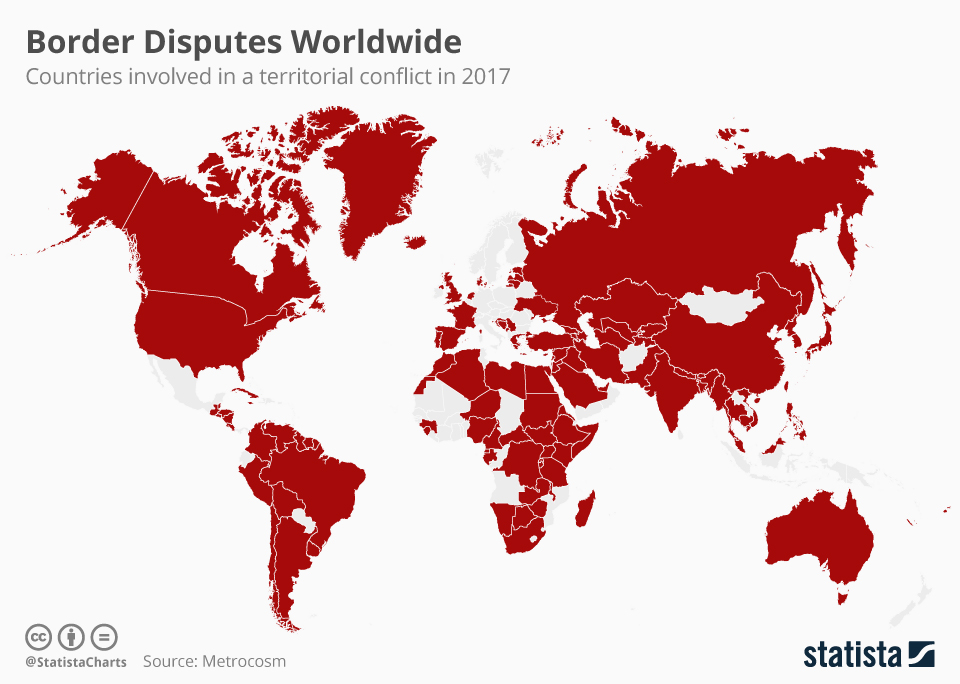Borders separate people, and those separations sometimes cause conflict. Borders and boundaries that are delineated by physiographic features that shift, such as the changing courses of rivers, may be one source of conflict, as the changing course of the river that delineated the boundary may cause one group to lose territory and another to gain (Biger, 2020). In addition, borders and boundaries can change through the amalgamation of adjacent territory. Other groups may also attempt to acquire territory that is geographically distant from them. This geographic and cultural disconnect often causes conflict, especially when these geographically distant people create borders without taking into account the local population.
One illustrative example of territorial powers creating boundaries and causing conflict is the “Scramble for Africa.” Between the 1880s and culminating 1900s, European powers began to claim the resources and territory of the African continent. By 1914, the continent had been divided amongst the colonial powers of France, Great Britain, Belgium, Spain, Italy, Germany, and Portugal, with only Ethiopia remaining independent. Many times these regions would be divided with straight lines, with little regard to the ethnic, tribal, and linguistic makeup of the inhabitants of the continent or the existing conflicts between those peoples. These colonial boundaries often split up ethnic groups, who had, and continued to maintain after border delineation, a shared identity (Michalopoulos and Papaioannou, 2017). This arbitrary delineation of an entire continent left long-lasting effects. Upon independence, many nations retained their colonial boundaries, not wanting to relinquish territory even if it would be in favor of more harmonious international boundaries that reflect the cultural nuances of the continent. The effects of these arbitrary boundaries continue to be felt in the conflicts that are seen throughout the continent, especially in the post-colonial wars that have taken place in Sudan, South Sudan, Nigeria, Liberia, Angola, Mozambique, and others (Prah, 2004). This is exemplified in your reading of Wubneh’s (2015) article about the Ethio-Sudan boundary issues. While this article was written in 2015, the border dispute is still quite active, as evidenced in the Peace and Security Council (PSC) report in March of 2021.
The examples from the African continent are just one example of colonial legacy boundaries spurring conflict globally. Some of the issues in Asia and the Middle East have their roots in colonial rule. The Sykes-Picot Agreement, also known as the Asia Minor Agreement, created spheres of influence for the British and the French in the Middle East in 1916, and has influenced many of the conflicts that surge in that region. You’ll learn more about the Sykes-Picot Agreement and its long lasting consequences in your group exercise this week.
There are many other types of border conflicts spanning the entire globe, each with their own unique nuances, oftentimes embedded in the identities of those nations and their peoples. The below map of Border Disputes in 2017 from Statista with data from Metrocosm demonstrates how pervasive border disputes and conflicts are globally. While this map is map is from 2017, it shows that there are very few areas of the globe not experiencing some level of border dispute.

References:
Biger, G. (2020). Historical geography and international boundaries. European Review, 29(1), 69-77.
Michalopoulos, S. and Papaioannou, E. (2017). The contemporary shadow of the Scramble for Africa. In S. Michalopoulos and E. Papaioannou (Eds.), The long economic and political shadow of history, volume 2 (50-65). CEPR Press.
Prah, K. K. (2004). African Wars and Ethnic Conflict - Rebuilding Failed States. Human Development Report Office Occasional Paper.
Wubneh, M. (2015). This land is my land: The Ethio-Sudan boundary and the need to rectify arbitrary colonial boundaries. Journal of Contemporary African Studies, 33(4), 441-466.